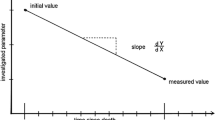Abstract
Purpose
Caffeine, a major ingredient of coffee and other drinks, causes minimal health problems. However, excessive caffeine intake may induce emotional and cardiac events. Studies on zebrafish larvae are considered useful for understanding drug poisoning because they can be used for multiple simulations.
Methods
The locomotion (swim distance) of zebrafish larvae exposed to varying concentrations of caffeine was measured using a light–dark test and an automatic video-tracking system. Mortality and heart rates were assessed 4 and 24 h after caffeine exposure and 24 h after caffeine removal.
Results
The heart and survival rates were reduced by exposure to caffeine of > 300 mg/L after 24 h in a dose-dependent manner; this was attenuated by caffeine removal at 4 h. Caffeine reduced the heart rate and survival considerably at 1000 mg/L, supporting the notion of caffeine-induced cardiac arrest resulting from bradycardia. The locomotion of zebrafish larvae during six alternating cycles of light–dark exposure was slower during light periods and faster during dark periods; 100–300 mg/L caffeine increased and decreased locomotion during light and dark cycles, respectively, with high inter-cycle reproducibility.
Conclusions
Given the anxiogenic effect of caffeine and light preference of zebrafish larvae, caffeine-induced changes in light–dark cycles could provide a new reliable marker for anxiety. Therefore, the “light–dark locomotion test” employed in this study is valuable for research on anxiogenic or anxiolytic substances. The test may allow simultaneous and automatic analysis of the locomotion of many fish under multiple conditions, thereby enabling evaluation of dose–response effects of caffeine.







Similar content being viewed by others
References
Cappelletti S, Piacentino D, Fineschi V, Frati P, Cipolloni L, Aromatario M (2018) Caffeine-related deaths: manner of deaths and categories at risk. Nutrients. https://doi.org/10.3390/nu10050611
Rana N, Moond M, Marthi A, Bapatla S, Sarvepalli T, Chatti K et al (2010) Caffeine-induced effects on heart rate in zebrafish embryos and possible mechanisms of action: an effective system for experiments in chemical biology. Zebrafish 7:69–81
Jabbar SB, Hanly MG (2013) Fatal caffeine overdose: a case report and review of literature. Am J Forensic Med Pathol 34:321–324
Kerrigan S, Lindsey T (2005) Fatal caffeine overdose: two case reports. Forensic Sci Int 153:67–69
Chan PK, Lin CC, Cheng SH (2009) Noninvasive technique for measurement of heartbeat regularity in zebrafish (Danio rerio) embryos. BMC Biotechnol 9:11
Tsai CT, Wu CK, Chiang FT, Tseng CD, Lee JK, Yu CC et al (2011) In-vitro recording of adult zebrafish heart electrocardiogram—a platform for pharmacological testing. Clin Chim Actam 412:1963–1967
Maximino C, Lima MG, Olivera KR, Picanço-Diniz DL, Herculano AM (2011) Adenosine A1, but not A2, receptor blockade increases anxiety and arousal in Zebrafish. Basic Clin Pharmacol Toxicol 109:203–207
Maximino C, da Silva AW, Gouveia A Jr, Herculano AM (2011) Pharmacological analysis of zebrafish (Danio rerio) scototaxis. Prog Neuropsychopharmacol Biol Psychiatry 35:624–631
Irons TD, MacPhail RC, Hunter DL, Padilla S (2010) Acute neuroactive drug exposures alter locomotor activity in larval zebrafish. Neurotoxicol Teratol 32:84–90
Lee SH, Kim HR, Han RX, Oqani RK, Jin DI (2013) Cardiovascular risk assessment of atypical antipsychotic drugs in a zebrafish model. J Appl Toxicol 33:466–470
Mehta A, Jain AC, Mehta MC, Billie M (1997) Caffeine and cardiac arrhythmias. An experimental study in dogs with review of literature. Acta Cardiol 52(273):283
Willson C (2018) The clinical toxicology of caffeine: a review and case study. Toxicol Rep 5:1140–1152
Schwerte T, Prem C, Mairösl A, Pelster B (2006) Development of the sympatho-vagal balance in the cardiovascular system in zebrafish (Danio rerio) characterized by power spectrum and classical signal analysis. J Exp Biol 209:1093–1100
Milan DJ, Peterson TA, Ruskin JN, Peterson RT, MacRae CA (2003) Drugs that induce repolarization abnormalities cause bradycardia in zebrafish. Circulation 107:1355–1358
Cockerill SL, Mitcheson JS (2006) Direct block of human ether-a-go-go-related gene potassium channels by caffeine. J Pharmacol Exp Ther 316:860–868
Flueck JL, Schaufelberger F, Lienert M, Schäfer Olstad D, Wilhelm M, Perret C (2016) Acute effects of caffeine on heart rate variability, blood pressure and tidal volume in paraplegic and tetraplegic compared to able-bodied individuals: a randomized, blinded trial. PLoS ONE 11:e0165034
Alia AO, Petrunich-Rutherford ML (2019) Anxiety-like behavior and whole-body cortisol responses to components of energy drinks in zebrafish (Danio rerio). PeerJ 7:e7546
Chen JN, van Eeden FJ, Warren KS, Chin A, Nüsslein-Volhard C, Haffter P et al (1997) Left-right pattern of cardiac BMP4 may drive asymmetry of the heart in zebrafish. Development 124:4373–4382
Schnörr SJ, Steenbergen PJ, Richardson MK, Champagne DL (2012) Measuring thigmotaxis in larval zebrafish. Behav Brain Res 228:367–374
Kalueff AV, Gebhardt M, Stewart AM, Cachat JM, Brimmer M, Chawla JS et al (2013) Towards a comprehensive catalog of zebrafish behavior 1.0 and beyond. Zebrafish 10:70–86
Fisone G, Borgkvist A, Usiello A (2004) Caffeine as a psychomotor stimulant: mechanism of action. Cell Mol Life Sci 61:857–872
Burgess HA, Granato M (2007) Modulation of locomotor activity in larval zebrafish during light adaptation. J Exp Biol 210:2526–2539
Maximino C, Marques de Brito T, Dias CA, Gouveia A Jr, Morato S (2010) Scototaxis as anxiety-like behavior in fish. Nat Protoc 5:209–216
Author information
Authors and Affiliations
Corresponding author
Ethics declarations
Conflict of interest
All authors certify that they have no affiliations with or involvement in any organization or entity with any financial interest or non-financial interest in the subject matter or materials discussed in this manuscript.
Ethical approval
The use of zebrafish for this study was approved by the Experimental Animal Committee of Tokyo Medical University (approval number: R2-0038). This article does not contain the results of any studies on human participants, performed by any of the authors.
Additional information
Publisher's Note
Springer Nature remains neutral with regard to jurisdictional claims in published maps and institutional affiliations.
Rights and permissions
About this article
Cite this article
Maeda, H., Hasumi, A. & Yoshida, Ki. Caffeine-induced bradycardia, death, and anxiety-like behavior in zebrafish larvae. Forensic Toxicol 39, 427–436 (2021). https://doi.org/10.1007/s11419-021-00577-8
Received:
Accepted:
Published:
Issue Date:
DOI: https://doi.org/10.1007/s11419-021-00577-8




